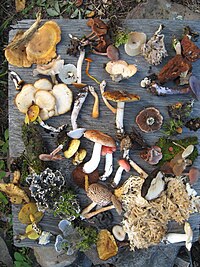
Photo from wikipedia
Abstract This study presents twenty years of Net Ecosystem Productivity estimations obtained using eddy covariance in a mixed forest, dominated by beech with sparse conifers, at the Vielsalm station, in… Click to show full abstract
Abstract This study presents twenty years of Net Ecosystem Productivity estimations obtained using eddy covariance in a mixed forest, dominated by beech with sparse conifers, at the Vielsalm station, in the Belgian Ardennes. First the quality and reliability of the data set is discussed. An uncertainty analysis showed that if, on one hand, the site heterogeneity and set-up changes may strongly affect yearly NEP estimates, questioning thus the total carbon budget relevance, on the other hand, robust inter-annual anomalies may be obtained as long as a site dedicated data treatment is carefully applied. A validation of the anomalies by comparison with a growth index derived from tree ring measurements is given. The resulting anomalies (range: [−206; + 123] g C m−2 yr−1, standard deviation: 93 g C m−2 yr−1) being larger than their own uncertainty (∼30 g C m−2 yr−1), an inter-annual variability analysis is possible. This analysis shows that the sources of NEP inter-annual variability at the Vielsalm station are multiple but the most prominent causes are biotic processes driven by carry-over effects of preceding meteorological events. The lowest observed NEP, in 2000, resulted from a bark beetle attack probably prompted by an early frost event in 1998. Besides, the robust lagged correlation between NEP anomalies and mean vapor pressure deficit during the preceding vegetation season also suggests a carry-over effect of water limitation during the previous year on the beech NEP. Mechanisms driving this carry-over effect are supposedly linked to tree physiology, which is confirmed by a dependency of canopy photosynthetic capacity to previous year water limitation. Some hypotheses, involving biomass allocation and bud formation, are proposed to explain its lagged impact on canopy photosynthetic capacity. Other causes of NEP inter-annual variability are the radiation during the current vegetation season and the temperature at the end of the winter but the latter variable rather indicates an effect on the conifers interspersed in the plot. Overall, the photosynthetic capacity combined with these two factors explained about 75% of NEP inter-annual variability.
Journal Title: Agricultural and Forest Meteorology
Year Published: 2018
Link to full text (if available)
Share on Social Media: Sign Up to like & get
recommendations!